Russian Virtual Computer Museum. → Hall of Fame → Oleg Konstantinovich Shcherbakov
Oleg Konstantinovich Shcherbakov
The Soviet expert – one of the first Chinese computer pioneers
Alexander Nitusov
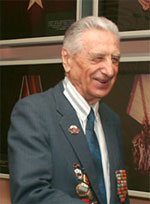
Oleg Shcherbakov (1923-2013)
Oleg[1] Konstantinovich Shcherbakov – veteran of the Great Patriotic War (WW2), scientific degree – “Candidate of Technical Sciences”[2], senior scientific collaborator /senior researcher/, scientist-veteran of the Institute of Precession Mechanics and Computer Engineering (IPMCE) and also “Honourable Veteran of the City of Moscow”; he worked at the IPMCE from 1951 till 2008.
Oleg Shcherbakov participated in design and development of the most of digital electronic computers, devices and computing systems created at the IPMCE, such as: BESM of the USSR Academy of Sciences, BESM-2, M-20, BESM-6, AS-6, Elbrus-3-1, all-round surveillance processors: PIKO, PIKO-V, PIKO-M). In 1957 Oleg Shcherbakov was also the first Soviet expert sent by the IPMCE administration on assignment to join the computer scientific and engineering team in Peking (China) for assistance in assembling the first Chinese digital electronic computer – BESM-K (modified BESM-2 of the IPMCE).
O.K. Shcherbakov authored more then 30 scientific publications and made number of inventions.
One should specially mention that O.K. Shcherbakov was a man of dignity, very reasonable, friendly, he had a smooth temper and great sense of humour.
Childhood and Family
Oleg Shcherbakov was born on the 8th of February 1923 in town of Simferopol. That time his father, Konstantin Pavlovich Shcherbakov, was student of the air-force academy (high school) in Crimea Simferopol's suburb Kacha (the first Russia's military aircraft school; established in 1910), to be a pilot. The mother lived in the city of Simferopol. After graduation the father with the whole family moved to Moscow, where he received position of a young pilots instructor at an air-force regiment.
Oleg's mother was unusually beautiful woman, she even played as actress in cinema-films. Unfortunately his parents divorced and the mother had to work as a theatre cosmetologist. However, she did her best to give Oleg (the only child) proper education, social training and good breeding in general. Shcherbakov always remembered her with sincere love and deep gratitude, as his most close person.
Oleg made very good progress at school. As he was a toll and strong young man, he was also active at sports. At the tenth (the last) form he joined sport school of martial arts at the sport centre “Dynamo” -then the central and the best one in Moscow.
The War
Early on Sunday morning, on the 22nd of June 1941, Oleg Shcherbakov went to stadium “Dynamo” for training. He came there directly from the school graduation party. To his astonishment Oleg found there a whole football team busy hammering sharp pikes into the football field. As he stood with his mouth literally wide open with surprise, one explained him that there would be defense constructions to protect the place from German (Nazi) parachute assault (!).
That was the war – the morning of the 22st of June 1941. Many Soviet young people went into battles directly from school graduation parties and many of them never returned home.
Soon Oleg was enlisted to fleet, but his real service started with some delay. First the train with new seamen was sent to the Caspian sea. However, a day later it was stopped and re-directed to town Arkhangelsk (literally “turned 180°”), to the North Navy facilities.
First they arrived to the Solovetsky Islands archipelago (near the Arctic Circle). Although being far in the north, they lie near important sea port Arkhangelsk – historically main terminal for the trade with Britain in the 15th – 18th centuries. The islands are famous for the huge Solovetsky Monastery complex built there in the mid-15th century. Besides its both religious and fortification functions, it was often used as the place of political exile. In 1921, after the Civil War (1918-1920), it was transformed into prison camp. However, in 1939 it was closed. By the beginning of the war a naval cadet training school for the Soviet Northern Fleet was established on its premises. There the navy officers formed professional teams of the newcomers.
As all of the arriving young men were graduates from secondary schools, that is received basic education, they were mainly offered to become cryptologists. Nevertheless, Oleg, who had already had some experience in radio-engineering, persuaded the officers to send him to the school of marine radio-masters.
The school was situated in rather exotic place – in the former prison at the monastery. Some former convicts remaining on the islands lived in, so-called, “free settlements”; the building was empty. The cadets pulled down and removed “everything unnecessary”; they transformed it, unexpectedly efficiently, into educational facility.
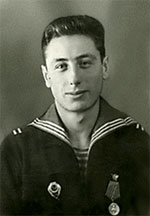
Oleg Shcherbakov, near the end of the war.
In winter 1942 educational course was completed; the young radio-masters received their qualifications. Then, they were given weapons and other equipment and had to make “forced” foot-march upon the ices of the White Sea, with all their “luggage” on their shoulders, to the railway station in town of Kem[3]. The march was a hard work, they should cover distance of 30 km in very cold windy wetter, among ice-mounds with no road at all. Luckily, nobody was injured, frostbitten or suffered in some other way. Although by the end of the march some were so exhausted that they could not hold guns in their hands, stark from polar cold. Late at the same night they boarded train, which transported them to Murmansk. After a short pause they arrived to small town (army base) Polyarny[4], which was a key defense line at the North Front, west from very important sea-port Murmansk. In 1942, after a series of heavy exhausting battles, the nazi army was defeated and beat off Murmansk, far to the West (to Norwegian border).
From 1943 Oleg Shcherbakov served at the monitoring and communications station, responsible for radio communications with the Soviet ships and for radio-monitoring over the enemy navy. He also sometimes worked at a mine-sweeping vessel which trawled naval mines and transported Soviet marine commandos to enemy's territory. By the end of the war Oleg graduated from the school of junior commanders and received rank of the First Class Radio-master and Boatswain's mate. Then he returned to the place of his service, where remained until the Victory Day.
Although Shcherbakov was mainly charged with radio-communications tasks, he also had to see actions sometimes.
He remembered talks with German soldiers, taken as prisoners of war. They spoke about sustained power of the Soviet soldiers with genuine respect. Soviet soldiers sometimes had to fight while staying (in trenches) up to the knee in cold water, while Germans themselves were mainly placed in well equipped shelters (sometimes even having a piano). As the history demonstrated, that was of no big help for them.
The British seamen also admired the Soviet sailors. The British battleships regularly arrived to the port Murmansk with military convoys, which transported weapons, equipment and food aid for the USSR. “The convoys looked very impressive”, remembered Shcherbakov. “Huge mass of ships with antiaircraft balloons tied to them on long lines.” “Sometimes they literally 'closed the view' so densely, that one could not see the sea behind them”. “Our (Soviet) ships went out into the sea to meet them. There were no very big Soviet battleships in the polar seas, but our submarines were rather numerous, efficient and very helpful. Germans were very scared of them, but the British seamen prized them highly and always spoke about them with gratitude. They always sighed with relief when reached the area where our submarines were waiting for them to escort. No wonder, their bold actions saved lives of many British seamen.”
In the first period of war army catering at the Soviet North front was perfectly organised. Plenty of high quality food was regularly supplied. However, after German advance in the Leningrad area the railways were cut and the Soviet troops in the north had to relay on the food (mainly canned food) delivered by The British and American convoys. Shcherbakov and other young sailors were regularly fishing; luckily the fish was so abundant that it could be easily caught with just bare fishing-hook. Once their boat was assaulted by a German aircraft. It shot at them, but, luckily, nobody was damaged. While the airplane was making a turn to repeat its attack the hapless “fishers” managed to row (like mad) to nearby rocks to hide among them.
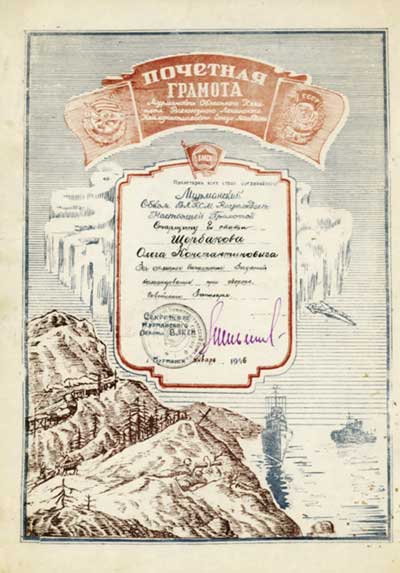
Shcherbakov's Certificate of Merit
When the war was over Oleg, still remaining at military service, entered department of distance learning of the Moscow Institute of Communications. In 1947 he left the army and returned to Moscow, to continue his education already at the institute's full-time department.
Engineer of the IPMCE
At the institute Shcherbakov made friends with a student Vladimir Alexeev. In spring 1951, after graduation Alexeev received position at the Institute of Precession Mechanics and Computer Engineering – IPMCE; several months later Oleg followed his example. They were some of the first assistants of S.A. Lebedev (Lebedev Sergey Alekseevich), who moved to Moscow from Kiev, in 1950, and headed the “Laboratory №1” (Laboratory of electronic digital machinery). Only Golovistikov and Neslukhovskiy came there before them. They were busy making central arithmetic device (Golovistikov) and control device (Neslukhovsky) of a new computer.
In Kiev S.A. Lebedev headed special (secret) laboratory at the Kiev Institute of Electro-energetics, where his team designed and manufactured the USSR first electronic digital computer MESM (МЭСМ).
Administrators of the institute's personnel department made Oleg quite friendly reception, however, warned that “Unfortunately, a big salary for the beginning engineer is not real. Just a position of the senior engineer and about 1600 Roubles a month”. Actually, after the student's monthly “incomes” (scholarship about 300 R.) that was a real fortune.
S.A. Lebedev invited Shcherbakov to join the computer power supply systems design team. Very unstable work of the direct current generators hampered development of a big computer. The generators were connected in parallel with acid accumulator batteries, which supplied computer's electronic components. That's why that was new and very actual research field for those times.
S.A. Lebedev asked Oleg to achieve their synchronization and stability in operation by implementation of electronic control circuitry (to replace inefficient, “archaic” coal regulators). Specialists know how difficult is this replacement in practice, and the electronic control in such devices had been simply “unheard of”. All coils were re-wound, feed-backs and electron tube based components were introduced.
Soon after an incident took place which unexpectedly influenced his whole professional life. When the BESM was practically assembled and ready for operation, it suddenly set on fire. Oleg Shcherbakov rushed to Lebedev, “Sergey Alexeevich, BESM is burning!”. “Immediately turn all power supply off!” Some defects in insulation turned out to be the reason.
Luckily the damages were not big. However, the basic problem was obvious – improved electric power supply system was needed, for the BESM's safe and faultless operation. S.A. Lebedev appointed Shcherbakov as the chief of the computer power supply systems development team. One should mention that Oleg was not just experienced engineer dynamic and initiative, but also did everything especially thoroughly. Lebedev charged him with new task – development of new system providing stable reliable operation of power supply generators.
The BESM fire stimulated total re-analysis of the cable lines structure and the entire organization of the power supply itself. Shcherbakov proposed converting of de-centralized power supply structure into the system with central console collecting all cables, which came from generators, and having all filters, circuit protecting breakers, indicators and other auxiliary equipment. Implementation of generator output voltage electronic control system permitted dismissing of power resistors, which were overheated during operation. As the resistors were mounted in the BESM itself (in its upper part) they were the source of a fire danger, both for the computer and for the rooms where it was placed. Thus, Oleg Shcherbakov successfully solved the problem.
S.A. Lebedev himself was experienced and respected scientist in the field of electro-energetics; one of his first scientific works was the monograph, “Stability of Electrical Systems Parallel Work” (1933). No wonder that he understood importance of the problem, solved by Shcherbakov, much better than many others and, therefore, highly appreciated merits of the young engineer, who made such advanced work all by himself. The BESM centralized power supply system was designed and implemented due to his efforts. As the result of that Shcherbakov became an “expert on power supply”. His contribution to the BESM project was awarded with the order “Red Banner of Labour”.
In spring 1952 new students of graduation year from the Moscow Power Engineering Institute (MPEI) arrived to the IPMCE. They were Burtsev Vsevolod Sergeevich, Melnikov Vladimir Andreevich, V.N. Laut and some other students from MPEI. Lebedev distributed among them design of various electronic computer units, as subjects of their diploma works. As the result their diploma projects formed basis for design and manufacturing of the next computer BESM-1 (БЭСМ-1). Then followed computer BESM-2 (БЭСМ-2) and original M-20 (ЭВМ М-20) based on dynamic flip-flops (triggers). Oleg Shcherbakov designed new power sources on magnetic amplifiers.
BESM-PRC[5] – the first Chinese electronic computer
(more detailed description of the Soviet-Chinese joint work on the computer BESM is given in the article “At the Cradle of the First Chinese Computer”)
(Actually, the computer was named BESM-K[6]) The Fifties were the period of the most close Soviet-Chinese cooperation. Collaborators of various Chinese scientific-research organisations permanently worked at the IPMCE as scientific and engineering trainees. When BESM-2 was put in operation Chinese authorities asked to assist in design and manufacturing of similar computer in Peking (Beijing).
Chinese decision to develop the BESM line in the own country was a sure evidence of the S.A. Lebedev's advanced scientific school's success. One should not forget that then, some Chinese engineers were also studying in the USA, and they, naturally, insisted on usage of american prototypes.
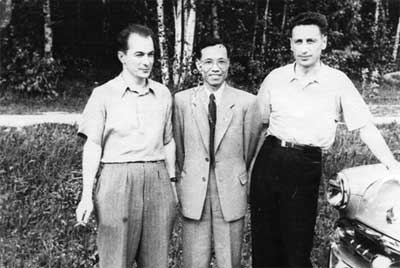
O.K. Shcherbakov (right, with his car), A.A. Pavlikov and a Chinese engineer-expert at the IPMCE
In the beginning of 1957 S.A. Lebedev dispatched Oleg Shcherbakov to China for consultations, technical assistance and evaluation of the Peking's specialists real possibilities. Shcherbakov became the first expert from IPMCE who worked in China at the Peking Institute of Computer Engineering (ICE).
Although his trip started with confusion – nobody picked him up at the Peking airport (information about his arrival was not timely received), it was fully compensated with the following, more then intensive, work and generally very friendly reception and attitude of the Chinese colleagues.
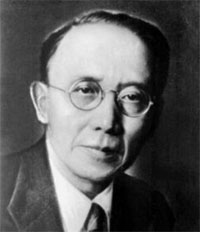
Guo Mouro (1892-1978)
The Institute of Computer Engineering in Peking was the basic organisation for computer research and development. That was the place where Chinese BESM would be assembled. The institute itself had been founded two years before the beginning of practical works. However, until Shcherbakov's arrival it was mainly busy with preparations: organisation of study in Germany, USSR and USA for its engineers. It also collected and analysed appropriate scientific and technical information.
The institute was established on the initiative of Guo Mouro the founder and first president of the Chinese national academy of sciences, who was the curator of the work BESM project.
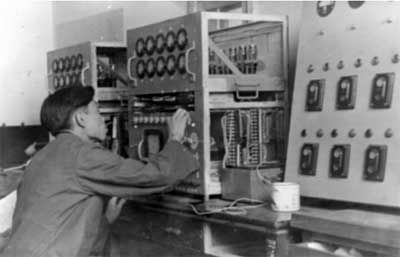
In China Oleg Shcherbakov was giving lectures on computer power supply devices, visited industrial enterprises in Peking, Shanghai, Nankin and other towns, made expert evaluations of their technical potential and helped in organisation of electronic components manufacturing by the Chinese plants. Until now he pays tribute to amazing industriousness of his Chinese colleagues, to their desire to study and understand everything and to their unique friendliness and hospitality.
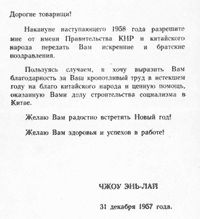
Christmas Greetings from Zhou Enlai to the Soviet colleagues.
Shcherbakov's comprehensive report to Moscow IPMCE was very positive; Lebedev was heartily satisfied with such state of things and sent the second expert to Peking. That was A.A. Pavlikov who joined Shcherbakov at the ICE. He was giving lectures on peripheral devices and assisting in their design. By that time a big scientific and engineering team was already working at the institute (ICE). Qualification level of the Chinese colleagues was steadily growing and the work on BESM was in full progress.
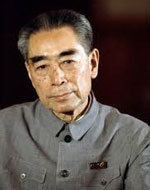
Zhou Enlai (1898-1976) – the Premier of the People's Republic of China (Chairman of the State Council)
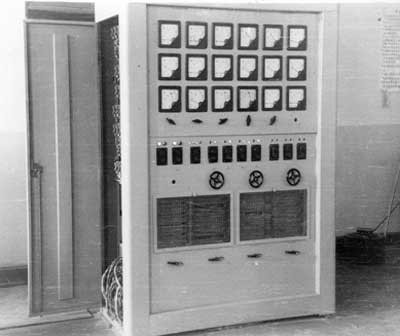
Instrument cabinet for power supply control, designed under O.K. Shcherbakov's guidance
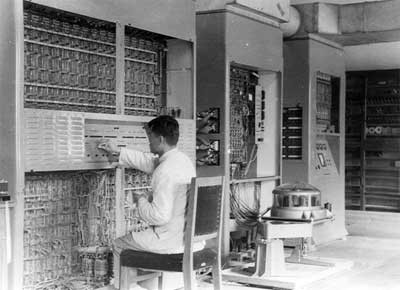
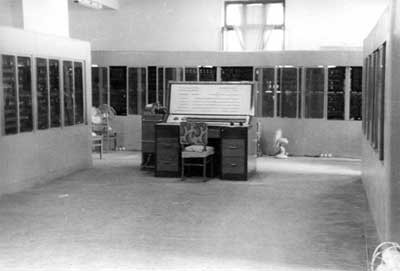
“The quickest computer in Asia”
One more engineer – Y.I. Vizun came from Moscow (IPMCE) to replace Pavlikov. After that, in autumn 1958, V.A. Melnikov – the head of the Soviet (IPMCE) expert group, arrived to perform the testing and necessary adjustments. He also officially accepted it in operation; the computer was given the name BESM-K and the title – “The quickest computer in Asia”.
In fact, Chinese computer repeated the Soviet BESM-2, with some improvements. The last one to come was A.S. Fedorov, who solved all remaining problems already in the process of computer stable operation, in 1959.
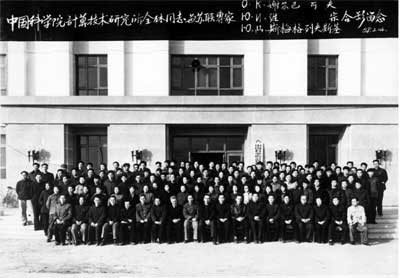
O.K. Shcherbakov and other IPMCE experts amid the scientists and engineers of the Chinese national Institute for Computer Engineering in Peking.
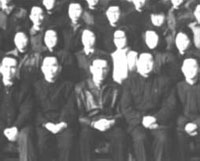
O.K. Shcherbakov with his Chinese friends (fragment of bigger photo above)
In 1958 Oleg Shcherbakov and four other IPMCE experts were awarded the big Chinese state medal “The Chinese-Soviet Friendship[7]”. The medal was given by the (first) premier of the People's Republic of China Zhou Enlai[8] (1898-1976) himself, who was always personally helping with organisation and control of the works on BESM-K.
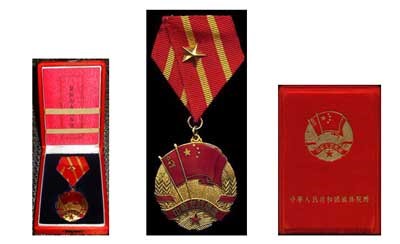
The medal “Chinese-Soviet Friendship”
“Very beautiful medal”, comments Oleg Shcherbakov. It's not just an award, but also a memory about a remarkable period in his life. He had spent in China more than half year.
Personal Greetings from Guo Mouro – the president of the Chinese Academy of Sciences:
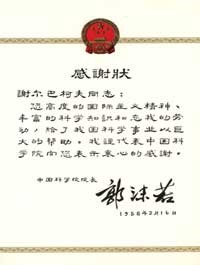
one more:
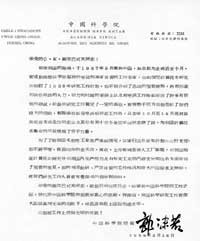
Translation:
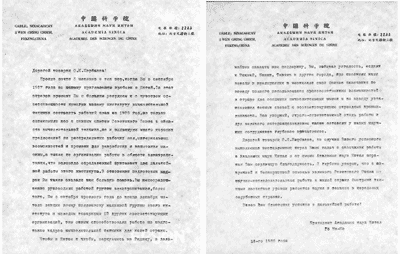
Back in Moscow
Meanwhile work of the IPMCR was in its usual progress. BESM-4 (БЭСМ-4) was completed – the first transistor-based computer. World-famous BESM-6 (БЭСМ-6) – the “Crown-Jewel” not only of S.A. Lebedev himself , but also of the whole Soviet computer engineering. As usual, Oleg Shcherbakov was responsible for power supply systems design.
In 1970 he was sent to the Great Britain, to the Royal Society. He received a place for scientific internship at the University of Manchester, with the subject: “Big Computers”. On his return to IPMCE he prepared and successfully defended dissertation for doctor degree in 1972 (Russ. “Candidate of technical sciences”). Academician S.A. Lebedev was the scientific supervisor of his dissertation work and V.A. Melnikov his main assistant. In 1986 Shcherbakov was awarded scientific title “Senior Scientist Researcher”.
BESM-6 (БЭСМ-6) became the basic computer for very powerful computing complex AS-6 (АС-6) – communication and information-processing system, which served at the main Soviet Spaceflights Control Centre. AS-6 (АС-6) operated with the famous coupling of the spacecrafts “Apollo” and “Soyuz” in 1975. AS-6 (АС-6) supported space complex station “Soyuz-Salyut” and space research program “Interkosmos”[9] (of the East European community).
Academician S.A.Lebedev (“Hero of the Socialist Labour”[10]), V.A. Melnikov and Andrey Sokolov (Sokolov Andrey Andreevich) were the AS-6 chief designers. Korolev Lev Nikolaevich was in charge of its operating system (software) development. Oleg Shcherbakov was appointed as the chief of the “Sector of the Computer AS-6 Logical and Technical state Control”.
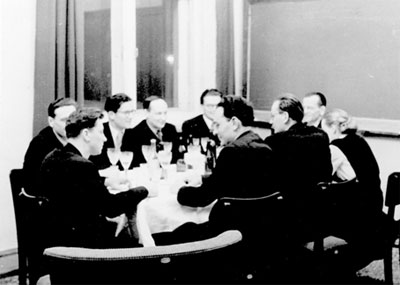
Meeting with American scientists at the IPMCE (O.K. Shcherbakov and V.A. Melnikov on the left)
“Idiotic PSCD”
The huge complex AS-6 occupied several stores of the Spaceflights Control Centre (SCC). Its peripheral devices were scattered among many rooms and sites; in fact, the whole system was a sort of local network. Such complicated configuration caused many difficulties in technical maintenance: most often the errors and faults happened because somebody simply forgot to timely turn something on somewhere, and the operators at the central control board didn't know about that. Naturally, in such cases an alarm signal was immediately given in all SCC buildings. After having worked there some time and taking part in several such “alarms” Oleg Shcherbakov himself designed “PSCD system” (Power Supply Control Device). His main idea consisted in permanent total current control over the whole distributed system (generally speaking, over all possible systems or structures).
That, seemingly, simple and logical (“self-evident”) idea, in reality came only to him. Shcherbakov and his assistants quickly made special board for the PSCD operator: since then, switching the AS-6 was permitted only after the network technical state information complete collection and analysis of its protocol.
When Vsevolod Burtsev, who was the chief of AS-6 works, saw the device the first time, he asked in (theatric) “General's tone”, “What for an idiotic structure is it?!”. Shcherbakov, who had worked with his colleague and age-mate for years, and knew him very-well, even did not turn his head to such “thrust”. After some period of AS-6 successful operating and -also successful- famous coupling of the “Soyuz” and “Apollo” spaceships, Burtsev unexpectedly himself produced an improved variant of PSCD. “Aha, but who has said “Idiotic structure”?”, sarcastically commented Shcherbakov; “Oh, come on -murmured Burtsev– 'twas a joke, as if you don’t know yourself”.
After the “Soyuz-Apollo” mission was completed Shcherbakov was awarded a medal and a special premium of the USSR Academy of Sciences, for his technical contribution, for the AS-6 power supply control and support and for his invention of the PSCD.
Later, Shcherbakov's team developed the control system making it even more advanced. Thus, they placed sensors and other control devices over all registers for the flip-flops failures and malfunctions monitoring.
Oleg Shcherbakov was going to develop the system even more up to the “machine-robot” level, so that it could automatically replace defect units (with the good ones) according to the fault signals. He was preparing microprocessors and even microcomputers as the automatic control means for diagnostics of complicated units and devices in computers and computing complex structures. That was very advanced and -what was important- quite realistic project. Had it been realised as planned there would be an unique “self-maintaining” automatic computation system. Unfortunately, the fall of the Soviet Union and -particularly- the economic degradation that followed, crippled the promising plans.
After S.A. Lebedev
Modular conveyor processor MKP (1 billion ops) became the next interesting design. Four pieces were produced before 1991: one remained at the IPMCE, another was sent to research centre at the town of Arzamas, the third one to the Moscow State University and the fourth to some defense research organisation. At the same time Shcherbakov was actively participating in cooperative project on MKP power supply systems development together with Polish colleagues. He visited Poland several times.
After finishing those works O.K. Shcherbakov, A.A. Sokolov and other specialists produced special processor for naval plan positioning (all round scan) systems. The device permitted to display (on screen) everything what a ship's radar could “see”.
Since 1992 O.K. Shcherbakov was engaged in development and optimisation of the processors for radio-location stations; and also was “traditionally” working on their power supply and cooling systems.
Shcherbakov has worked for the IPMCE 57 years altogether, from 1951 till 2008. All that time he was also active at social work, he was the chairman of the veterans council and founder of the institute's museum. In 2008 this museum was the number one on the list of Moscow scientific and patriotic museums.
Shcherbakov has been awarded the “Order of Patriotic War” (II degree) (https://en.wikipedia.org/wiki/Order_of_the_Patriotic_War), order “Red Banner of Labour” and 22 medals.
He was actively working until his last days. Luckily Oleg Konstantinivich Shcherbakov could celebrate his 90 years jubilee, within the circle of his family and friends.
Two his sons are Vladimir, a programming engineer and Alexey, he has scientific degree “Candidate of Technical Sciences“ (doctorate) and is a chief of department at the Scientific Research Institute of Hydraulic Engineering, Alexey is a laureate of the Russian Federation government's premium “For Scientific and Engineering Contribution”; both of them are persons of worth, respected by their colleagues, friends and relations.
Notice
Materials, documents and photos for this publication have been given to the author by O.K. Shcherbakov himself. The final text was also proved by him.
Notes
1. Oleg (name) – Russian form of Scandinavian name Holger/Holmger.
2. More on scientific degree “Candidate of Sciences”: https://en.wikipedia.org/wiki/Candidate_of_Sciences
3. https://en.wikipedia.org/wiki/Kem,_Russia
4. https://en.wikipedia.org/wiki/Polyarny,_Murmansk_Oblast
5. PRC – People's Republic of China.
6. It was named BESM-K, where K stays for “K_i_t_a_i” – Russ. for “China”
7. https://zh.wikipedia.org/wiki/%E4%B8%AD%E8%8B%8F%E5%8F%8B%E8%B0%8A%E4%B8%87%E5%B2%81%E5%8B%8B%E7%AB%...
8. https://en.wikipedia.org/wiki/Zhou_Enlai
9. “Interkosmos” – https://en.wikipedia.org/wiki/Interkosmos
10. “Hero of the Socialist Labour” – the USSR highest civil award/honourable title completed with the medal “Gold Star” and number of social privileges.



